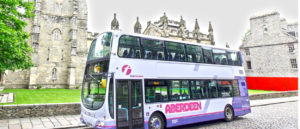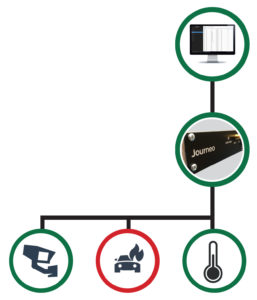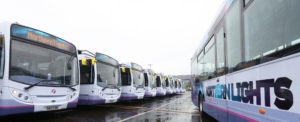Highlights
- The Journeo Remote Condition Monitoring platform reports system faults in real-time
- The IoT-connected technology allows systems to be proactively maintained
“The implementation of the Journeo RCM platform, coupled with 21st Century’s AWS programme, has seen download availability increase by 10% – so not only is it more cost effective than traditional service models, it yields better results, too.” Michelle Grosvenor, Head of Insurance, First Bus
Customer requirements
CCTV has become an invaluable tool for fleet operators and protects the safety of First Bus’s 1.6 million daily customers, staff and safeguards the integrity of operations. The ability to download and utilise footage has provided First Bus with the tools to protect its businesses from fraudulent insurance claims and obtain a true account of events.
With an operational CCTV system installed, the reality is that the clear majority of footage will never be viewed, which can result in faults on systems going unnoticed until it is too late and therefore, required footage cannot be obtained.
Standard industry service models generally operate in one of two ways:
- Reactive maintenance – the CCTV maintainer is called to repair an installation upon a fault being spotted and reported
- Preventative maintenance – scheduled visits aimed at preventing errors occurring by assessing system health and carrying out running repairs.
Even with preventative maintenance, a window remains where a system may potentially fail and a fault is not recorded and a repair effected until it is too late.

Solution and technology
First Bus engaged 21st Century to implement the Journeo Remote Condition Monitoring (RCM) platform across all vehicles with a mobile CCTV installation, coupled with the transport technology company’s managed maintenance programme, the Adoptive Warranty Scheme (AWS), which sees 21st Century maintain all enrolled vehicles to the same high standards as new installations still in their warranty period. The platform reports system health in real-time, allowing for engineering support to be scheduled as soon as a fault occurs and, as the system develops, big data rules incorporated into the platform are beginning to predict failures before they happen.
With over 6000 vehicles in the fleet, CCTV system architecture can vary dependent upon the age of the vehicle, vehicle type and the specification and layouts of regional operating companies. The challenge involved implementing a solution that would not only work with the latest technologies, but also connecting legacy systems to the Internet of Things (IoT) to drive improvements in CCTV download availability that can be realised through intelligent systems.
At its most basic level, there are three key elements to the Journeo Remote Condition Monitoring platform:
- A small, discreet, on-vehicle unit/application: Dependent upon the equipment included within the CCTV design, health status information is gathered via an on-board unit (analogue or digital versions available) or where possible, a virtualised instance of the application within existing equipment. System health audits are completed on system start-up and throughout the service. The unit filters health messages to ensure veracity and compresses to a minimal file size, before securely transmitting data to the cloud-based platform.The units and applications work with all major DVR/NVR manufacturers and model variants including (but not limited to) Timespace, Hikvision and AD.
- Cloud-based platform: The platform ingests data from the on-vehicle units/application and interprets the data. As the pool of connected devices increases, proprietary algorithms can identify not only existing faults, but data patterns that may indicate an imminent or future failure and categorise accordingly. The outcome is then reported to nominated users and systems.
- Reporting: Reporting takes several formats:
a. Direct emails to nominated users to alert of system failure.
b. API directly into the First Bus Fleet Management tool, TracerIT, to enable automatically scheduled Engineering visits.
c. Online web-portal, controlled by strict User Rights Management conditions, to allow nominated users to gain an insight into fleet-wide trends and drill down into specific data via the user dashboard.

The Journeo Remote Condition Monitoring Platform has the capability to do more than report on the health of CCTV installations and can in fact be configured to report on the system of health of most installed systems, including (but not limited to) fire suppression and HVAC.

Delivery
Roll out of the system is ongoing, with over 1000 CCTV installs now benefitting from the RCM platform. The platform is being implemented on new buses, in addition to bringing the benefits of IoT-connected technology to legacy systems.
Dependent upon the system architecture and DVR platform installed, the Journeo RCM platform is capable of reporting down to accessory level and is able to pinpoint issues with specific cameras and as the pool of installations is increasing, is applying “big data” concepts to analyse intermittent faults and data patterns leading up to faults in order to predict future failures.
The primary benefit of CCTV download availability is already being recognised by the First Bus insurance team. Fleets that have been connected to the Journeo RCM platform are reporting a 10% increase in availability of download footage when coupled with a managed maintenance programme (to ensure a repair is effected when a fault is reported) in comparison to download availability prior to the implementation of the platform.
The RCM platform also has the side-benefit of keeping vehicles where they should be – on the road – as there is no need to take vehicles out of service for preventative maintenance visits when they are not necessary.
The safe and efficient movement of people and goods will be essential to the development of smart cities and the implementation of intelligent systems within First Bus demonstrates a clear commitment to utilise scalable technologies to connect not only new solutions, but also legacy systems to the Internet of Things for the benefit of their operations and, ultimately, their passengers.
“The Remote Condition Monitoring platform intelligently communicates with our internal asset management system, meaning that even our legacy systems are benefitting from the investments First Bus are making to safeguard our passengers, staff and operations.” Michelle Grosvenor, Head of Insurance, First Bus
